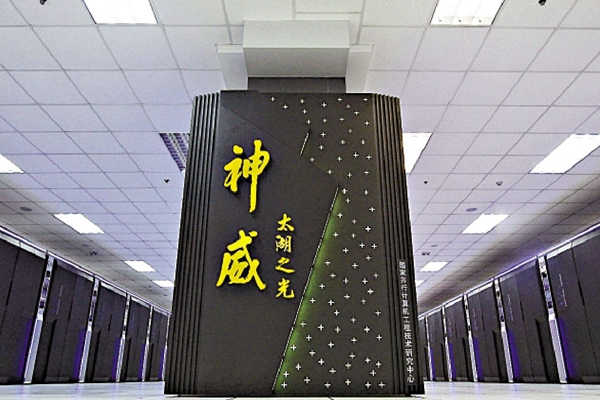|

|
|
China’s Sunway TaihuLight [File Photo]
|
China’s Sunway TaihuLight and Tianhe-2 are still the world’s fastest and second fastest machines, but America’s Titan was squeezed into fourth place by an upgraded Swiss system, according to the latest edition of the semiannual T0P500 list of supercomputers released Monday.
China’s homegrown supercomputers
Sunway TaihuLight, described by the T0P500 list as “far and away the most powerful number-cruncher on the planet,” maintained the lead since last June, when it dethroned Tianhe-2, the former champion for the previous three consecutive years.
It means that a Chinese supercomputer has topped the rankings maintained by researchers in the United States and Germany for nine times in a row.
What’s more, Sunway TaihuLight, with a performance of 93 petaflops, was built entirely using processors designed and made in China.
“It highlights China’s ability to conduct independent research in the supercomputing field,” Haohuan Fu, deputy director of the National Supercomputing Center, where Sunway TaihuLight was installed, told Xinhua.
“China is simultaneously developing hardware and software technologies of supercomputers,” Fu said. “It is expected that rapid development in homegrown hardware technologies, supported by homegrown software, will lead to a stronger research and engineering test capacity in many fields, thus promoting an industrial upgrading and, eventually, a sustainable development of China’s homegrown supercomputing industry.”
Tianhe-2, capable of performing 33.9 petaflops, was based on Intel chips, something banned by the U.S. government from selling to four supercomputing institutions in China since 2015.
Swiss system “really a surprise”
In the latest rankings, the new number three supercomputer is the upgraded Piz Daint, a system installed at the Swiss National Supercomputing Center.
Its current performance of 19.6 petaflops pushed Titan, a machine installed at the U.S. Oak Ridge National Laboratory, into fourth place. Titan’s performance of 17.6 petaflops has remained constant since it was installed in 2012.
“This is the second time in the 24-year history of the TOP500 list that the United States has failed to secure any of the top three positions,” the TOP500 organizers said in a statement.
The only other time this occurred was in November 1996, when three Japanese systems captured the top three spots.
“Nevertheless, the U.S. still claims five of the top 10 supercomputers, which is more than any other nation,” they said.
Fu called the upgraded Swiss system “really a surprise,” saying that “it reflects the increased investment in large-scale supercomputers in Europe.”
America’s strong strength
“Although the U.S. dropped out of the top three, it still has strong strength in high performance computing,” Fu told Xinhua. “If everything goes well, we could see two U.S. systems with a performance of 200 to 300 petaflops in the next rankings at the end of the year.”
Just days before the TOP500 announcement, the U.S. Department of Energy said it has awarded AMD, Cray, HP Enterprise, IBM, Intel and NVIDIA a total of 258 million U.S. dollars in funding to accelerate the development of next-generation supercomputers.
“Continued U.S. leadership in high performance computing is essential to our security, prosperity, and economic competitiveness as a nation,” U.S. Secretary of Energy Rick Perry said in a recent statement.
The immediate goal of the United States is to develop at least one exascale-capable system by 2021, which will be at least 10 times faster than China’s Sunway TaihuLight.
“Global competition for this technological dominance is fierce,” the U.S. Department of Energy asserted. “However, the U.S. retains global leadership in the actual application of high performance computing to national security, industry, and science.”
In addition, the latest list showed that the United States leads the pack in the total number of TOP500 systems, with 169, while China is a close second with 160. Both countries lost share compared to six months ago, when they each claimed 171 systems.
Besides the United States and China, the most well-represented countries on the list are Japan, with 33 supercomputers, Germany, with 28, France, with 18, and Britain, with 17.
Overall, aggregate performance on the TOP500 rose to 749 petaflops, a 32 percent jump from a year ago.
Such an increase, though, is well below the list’s historical growth rate of about 185 percent per year, said the organizers.
“The slower growth in list performance is a trend that began in 2013, and has shown no signs of reversal,” they said.
When it comes to companies making these systems, the U.S.-based Hewlett-Packard Enterprise claims the number one spot with 143 supercomputers. China’s Lenovo is the second most popular vendor, with 88 systems, and Cray is in third place, with 57.
There are three other Chinese companies in the vendor list: Sugon (No. 4 with 44 systems), Inspur (No. 6 with 20 systems) and Huawei (No. 7 with 19 systems).
The Top500 list is considered one of the most authoritative rankings of the world’s supercomputers. It is compiled on the basis of the machines’ performance on the Linpack benchmark by experts from the United States and Germany.
![Two snow leopard cubs have recently been spotted in bushes in the headwater region of the Yangtze, China's longest river. [Photo provided by Shan Shui Conservation Center] Two snow leopard cubs have recently been spotted in bushes in the headwater region of the Yangtze, China's longest river. [Photo provided by Shan Shui Conservation Center]](http://images.china.cn/attachement/jpg/site1007/20170620/b8aeed9904561ab2aedb13.jpg)
